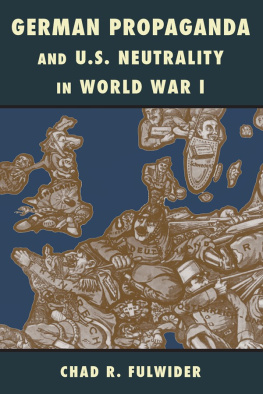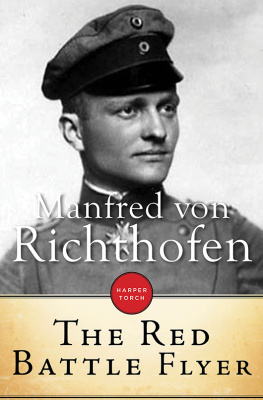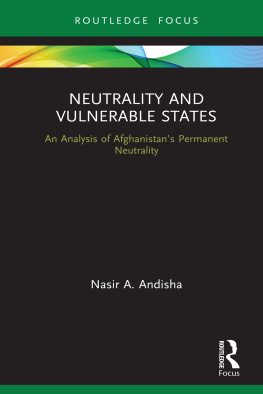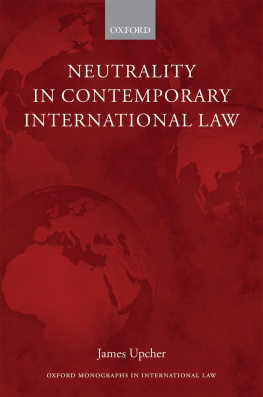German Propaganda and U.S. Neutrality in World War I
Copyright 2016 by The Curators of the University of Missouri
University of Missouri Press, Columbia, Missouri 65211
Printed and bound in the United States of America
All rights reserved. First printing, 2016.
ISBN 978-0-8262-2058-5
Library of Congress Control Number: 2015955242

This paper meets the requirements of the American National Standard for Permanence of Paper for Printed Library Materials, Z39.48, 1984.
Typefaces: Garamond, Futura
ISBN 978-0-8262-7343-7 (electronic)
Preface
In the fading evening light of August 4, 1914, Great Britain launched its first attack of World War Ithe C.S. Alert severed the five transatlantic cables linking Germany and the United States. Thus began the most decisive battle of World War I: the battle for American public opinion fought on American soilfirst the struggle for accurate information, then subsequently for tangible assets. Without American shipments of munitions, material, and money to the Allies, the war would have undoubtedly taken a different course.
For both the British and the Germans, the most important question was, Will the United States enter the war? By failing to obtain true American neutrality, the German government could not hope to stem the Allied tide for the duration of the war, even without the impact of American soldiers on the Continent.
This study analyzes the attempts of the German Foreign Ministry, German organizations, the German-language press, and German-American activists to counter the ever-increasing pro-Allied stance of the American media after August 1914 in a desperate struggle to keep the United States out of the war.
This project explores German reactions to American nonneutrality and Allied propaganda through archival records, newspapers, and official propaganda to assess the cultural impact of Germanys political mission within the United States. By revealing the reactions and behavior of German-Americans, this study further explores the experience of immigrants in American society, the impact of World War I on both American and European society, and the perception of American life in Europe.
Acknowledgments
The author wishes to express sincere appreciation to Astrid M. Eckert, James Van Horn Melton, and Fraser J. Harbutt for their untiring guidance and assistance in the development and evolution of this initial research. Special thanks as well go to Holger Afflerbach, whose expertise in the history of the First World War helped to frame this study from its earliest phase through its completion. I also wish to thank Jessica, my friends, and family; without their support and encouragement, none of this would have been possible. While historical research is a collaborative effortand Astrid, Holger, Jamie, Fraser, Gnther Kronenbitter, Karen Bosnos, Daniel Krebs, and Jonathyne Briggs, Spencer Dew, and Matt Murphy have all contributed to the development of this projectany mistakes or errors in this manuscript are fully my own.
List of Abbreviations
| AA | Auswrtiges Amt (Foreign Office, Germany) |
| ACFC | American Correspondent Film Company |
| CCV | Catholic Central Verein |
| DANB | Deutsch-Amerikanischer National Bund (National German-American Alliance) |
| GIS | German Information Service |
| GSP | German Society of Pennsylvania |
| GUL | German University League |
| MCC | Mixed Claims Commission |
| NA | National Archives, Washington, D.C. |
| NGAA | National German-American Alliance |
| PA | Politisches Archiv (Political Archive, Foreign Office, Germany) |
| PGL | Pan-German League |
| Ver.St.v.N.A. | Vereinigten Staaten von Nordamerika (United States of North America) |
Introduction
The Kaisers Most Loyal Subjects?
The German View of America and German-Americans during World War I
ON 9 August 1914, the New York Times carried pictures of German and French reservists marching in parades and rallying around their national colors.
With the outbreak of war in August 1914, the major newspapers of the United States reported daily parades, rallies, and protests on the part of various ethnic groups and recent immigrants to this country in response to the declarations of war witnessed by the world through Europe. Every major European power called for its sons to return home to serve the nation in the cause of righteousness, to defend the homeland against the threat of foreign aggression. As many early newspaper reports illustrate, Germans in the United States responded immediately to the crisis of war. Support of the Fatherland was not confined only to first-generation Germans or to young men who had emigrated to the U.S but were still obliged to serve in the Germany army as reservists. Instead, this spontaneous outpouring of support for the German cause extended to many American citizens of German descent. The National German-American Alliance (hereafter NGAA), the largest organization of German-Americans, called a mass meeting on 5 August 1914 to protest against any American participation in the war.
By mid-1915, however, the situation for German-Americans had begun to change significantly. After the sinking of the British passenger liner Lusitania, which resulted in the deaths of 1,198 people, including 128 Americans, Harvard professor Hugo Mnsterberg described the assault upon Americans of German descent. Much of it was provoked by the anti-German propaganda created by the Allies, but deeper suspicions of German militarism and ruthlessness also biased many Americans against the hyphenatesGerman-Americans. Where before German immigrants had been seen as productive members of American society with a long history of contributions to American society and the formation of the United States, the experience of World War I threatened their very identity as an ethnic group. Many Americans of German descent lost their jobs, were cut off from friends and colleagues, and looked on while their American children became marked as outcasts. There had been waves of anti-immigrant sentiment during the nineteenth century, but not on a scale comparable to the anti-German campaigns during the war. Had the good will of the pastextending back to the founding of Germantown, Pennsylvania in 1683been false? The real consequences of American public opinion against Germany, according to Mnsterberg, were the true tragedies brought into the homes of loyal Americans of German descent. Invoking his own experience as a target of anti-German insults, Mnsterberg, a naturalized American citizen, proclaimed, the truth alone will make us free from strife.... To understand our misunderstanding is the only thing which we can contribute today toward a lasting peace.
A Critical Appraisal of German-American Relations
Given the widespread outpouring of support for the German cause in the first months of the war, how did the German government attempt to influence American public opinionparticularly among those who were considered to be the Kaisers most loyal subjects the United States neutral. Their mission was to counter the Allied propaganda campaign and to defend the German justifications for war. Toward this end, they attempted to tap the significant potential of German-Americans as a political force to influence American public opinion in a positive pro-neutral direction. Thus, the German officials viewed the diverse and highly fragmented groups of German immigrants throughout the United States as a well-organized, fairly homogenous group that they believed would be sympathetic to their efforts. They also believed that they could induce this group to rally together as a political force that could represent German interests within the United States. While we know that the ultimate result of Allied propaganda and German military action was American entry into the war against Germany, this conclusion was by no means clear in 1914 or 1915. By 1916, there were clear signs that President Wilsons peace initiatives might be successful, if he could compel the Allies to negotiate.
 This paper meets the requirements of the American National Standard for Permanence of Paper for Printed Library Materials, Z39.48, 1984.
This paper meets the requirements of the American National Standard for Permanence of Paper for Printed Library Materials, Z39.48, 1984.








